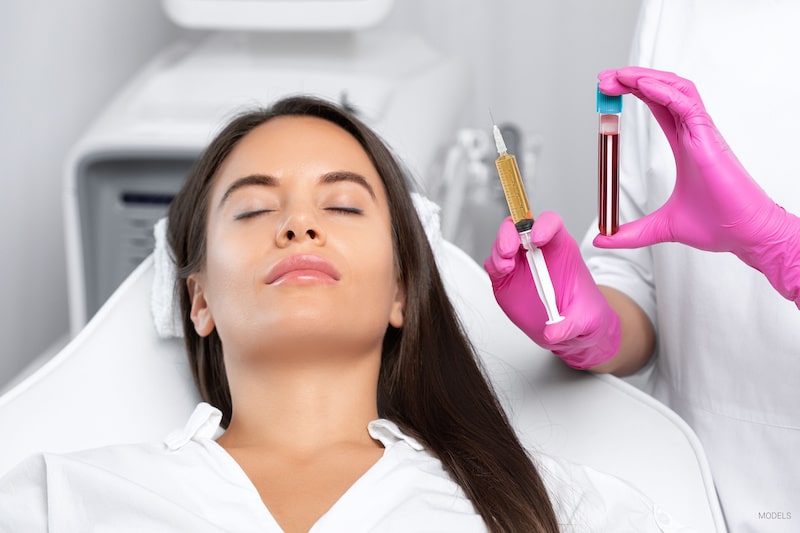4 Minute Read:
Technology and medicine are constantly improving. Thanks to these advancements, we can achieve significant cosmetic improvements more effectively and efficiently than ever before.
One of the most beneficial of these is platelet-rich plasma (PRP). PRP has long been used with great success in the medical field to help regenerate tissue after injuries and degenerative diseases.
 Now, PRP is being used to enhance the results achieved with various cosmetic treatments and procedures, including facial rejuvenation and hair growth.
Now, PRP is being used to enhance the results achieved with various cosmetic treatments and procedures, including facial rejuvenation and hair growth.
Below, we will take a look at PRP and discuss five of the most beneficial uses for PRP in cosmetic treatment.
What Is PRP?
PRP is a concentration of two parts of your blood: the liquid (plasma) and blood cells responsible for healing the body of injuries (platelets).
Platelets contain numerous growth factors that can help with cell reproduction. What makes PRP even better is that it comes from you, making it all-natural.
Once a sample of your blood is taken, it is placed into a centrifuge machine that spins it at a high speed. This process separates the platelets from the other blood cells. These separated platelets are then gathered and used for various cosmetic purposes.
How Can PRP Help Cosmetic Results?
The benefits of platelet-rich plasma are substantial, especially when combined with other cosmetic treatments and procedures. This is because PRP helps to speed up recovery by healing the soft tissue and producing new and healthy cells.
Here are five cosmetic ways PRP can help:
1. PRP as a Facial Filler
Many patients turn to dermal fillers like BELOTERO BALANCE® and JUVÉDERM® for their various concerns. These injectables are extremely useful in filling wrinkles, fine lines, and volume loss, but while they often contain natural ingredients like hyaluronic acid (HA), they are still foreign materials.
Unfortunately, while rare, it is possible for some patients to reject or have an allergic reaction to these substances.
PRP offers similar results to injectable fillers by stimulating the body’s natural collagen production. This is important since collagen is responsible for the skin’s strength, health, and elasticity, meaning that you can achieve smoother, firmer, and fuller looking skin after a PRP injection.
2. PRP With Microneedling
Whether it be wrinkles, acne scars, pigmentation issues, or other facial blemishes, microneedling with the Dermapen® is one of the most effective ways to improve the look and appearance of your facial skin.
During a microneedling treatment, the Dermapen® will create a series of tiny punctures (micro-injuries) in the skin. This process forces a natural healing response, and in turn, strengthens the skin.
By adding PRP to your microneedling treatment, you can achieve even better improvement to the skin’s quality and appearance. Additionally, the PRP helps to speed up the recovery process.
3. PRP for Hair Growth
One of the most promising applications of PRP comes from its ability to combat hair loss.
Because PRP helps to promote collagen and heal dormant or injured cells, PRP can help stimulate hair growth. The growth factors in the platelet-rich plasma increases blood supply in the follicles to improve hair growth.
4. PRP With Laser Treatment
Laser treatments help tighten the skin, improve pigmentation, and reduce the appearance of wrinkles and fine lines.
Laser treatments can be either ablative (where the top layers of skin are removed) or nonablative (where no skin is removed).
When PRP is added to laser skin rejuvenation, you can often heal quicker from the laser treatment, and because collagen production is promoted, you can look forward to improved skin texture for long-lasting results.
5. PRP With Fat Grafting
Fat grafting (also known as fat transfer) is a procedure where liposuction surgery is used to transfer fat from one area of the body to another. For this procedure, fat is harvested from an area with extra fat (usually the abdomen, hips, or thighs). This fat is processed and is then injected into an area of the body that you want to augment in volume (most commonly the face or breasts).
When PRP is added to fat grafting, recovery and healing is sped up, there is a higher chance of the fat surviving the process, and there tends to be less side effects (bruising and swelling) at the injection site(s).
Want to Learn More?
If you are interested in finding out more about PRP and how it can help you achieve the aesthetic look and feel you desire, contact Bridges to Beauty by calling (318) 219-8555 or by filling out our online contact form.

